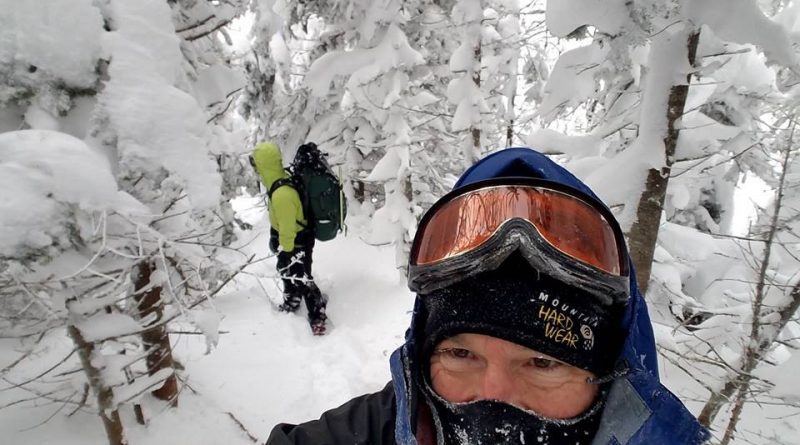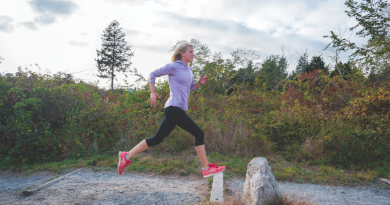How Extremus Hikers Handled A Very Cold Day
On the coldest weekend of the winter, members of the Endurance Society set out to hike the Adirondack’s high peaks. Was it extreme? Or just “Extremus?” Three participants tell the story—scroll down for a Trek Report by Andy Weinberg and Erica Simister.
Part I: By Lance Parker
In the winter, especially on days like January 6, 2018, those at the highest risk of exposure are those who are looking out for others.
I had led the charge to treeline on Mount Marcy in the Adirondacks as eight members of our group, The Endurance Society, attempted the summit. Seven had already turned around to leave the mountains.
With the winds gusting between 45 and 60 miles per hour, I pulled to the rear and kept my eyes on the slower members. It was approximately -25F ambient temperature on the summit. According to the National Oceanic and Atmospheric Administration, the windchill factor brought temperatures as low as -69F.
I began to worry for the four members in the back of our group of eight. They were clearly hypothermic and had splotches of frostnip on their faces. Frostbite could kick in on their noses and cheeks in a matter of minutes.
I ran ahead to catch up with Andy Weinberg, our leader, to tell him I was turning them around, screaming through the gust of wind that broke through the nylon in my hood. He agreed to meet me back at treeline. Fumbling in the wind as I lowered my face mask and raised my iced-over goggles, I yelled back through the ice-cold air to the group staggering below.
Just seeing me turning away from the summit made a couple of them turn around, as if enlightening them that up is not the only direction.
I’m a pretty simple guy; my girlfriend says that makes me complicated though. In the winter I like three things: moving in the woods, the cold days, and everything that combines those two things.
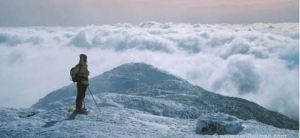 This might be why I agreed to join the Extremus hike again this year, even after knowing what the forecasted temperatures would be. I knew that we might not see windchill temps higher than -30F with the wind breaking through the trees, even in the valley.
This might be why I agreed to join the Extremus hike again this year, even after knowing what the forecasted temperatures would be. I knew that we might not see windchill temps higher than -30F with the wind breaking through the trees, even in the valley.
I’ve been with the Extremus group all three years and we’ve never finished the trek, but as Andy says, “the idea is to come for the community and the challenge, and not worry about winning or losing as there are no winners or losers.
“Extremus” is the brainchild of Andy Weinberg, founder of the Endurance Society, which organizes events that test athletes’ limits. Other events include things like Infinitus, an 888-kilometer running race.
Andy, a professor at Castleton University, has competed in more than 100 ultra marathons, double and triple Ironmans and even a quintuple Ironman (that’s a 12-mile swim, 560-mile bike, 131-mile run.) The first two Extremus events were group endurance hikes held in the dead of winter in Vermont. “The purpose of the trek might be debatable, but if you think it’s supposed to be easy, it’s not,” Andy says about Extremus.
In 2016, Extremus aimed to take a group for 50 miles along the Long Trail. That year, it was unexpectedly warm. Rain and strong winds pummeled the group and two hypothermic hikers were rescued after 25 miles.
This year, the forecast went in the opposite direction: the forecasted high on Mount Marcy was going to be -55F with windchill.
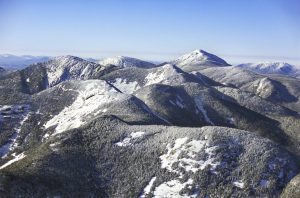
I signed up for a New Year’s Eve 5k three days before the race because the forecasted high was -25F with the windchill. I slept outside of the cabin the night before the event. Even my crazy friends think I’m crazy.
The people who do Extremus aren’t your ordinary people. Among the 2018 Extremus group were Wilderness First Responders, a nurse, ultramarathon runners, people who have stood on Mount Rainier, Mount Aconcagua (the highest mountain in South America), and Mount Washington in 100-plus m.p.h. winter winds. I’m a licensed hiking guide through the New York Department of Environmental Conservation, and an endurance athlete.
The night before we left, Andy, myself, and a few other Endurance Society members had a conversation with two concerned park rangers. They left satisfied that we had a long contingency plan, a committed support crew, and a licensed hiking guide.
Mount Marcy proved to be a manageable threat that day. That afternoon though, we would find ourselves in the middle of a more technical challenge: getting over the steep south face of Saddleback Mountain.
Three members of our crew had already made it known that they didn’t want to be a part of the full journey and headed out.
What we thought would be a simple climb up and over the mountain to the next trail junction turned into the climax of our day. It was just an eighth of a mile and 100 vertical feet, but it would take us an hour and a half to cross, all in full wind exposure. With three major cruxes in this section, we had three separate bottle-necks happen back-to-back-to-back as hikers slowed down in narrow sections of the trail.
This type of slow moving in extreme conditions is what brings on danger. I led the group on all three spots and helped each member of our crew across. I had to stop after about 30 minutes to put on every piece of clothing I had.
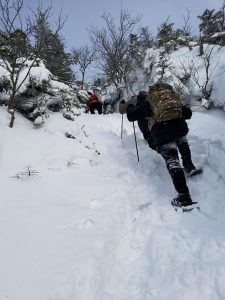
Shivering in the wind at the top of a ten foot rock and ice chimney, I had to take my mittens off, kneel in the snow with my snowshoe crampons dug into a thin layer of ice, and one by one, pull up each member of the group, commanding them where to put their feet. By the time the last members of the group made it up, everyone was hypothermic.
At this point, Andy was fumbling, and quiet. He grabbed the wrong backpack instead of his own. He had just stood still for almost 45 minutes at the bottom of this last traffic jam. I was worried about myself, so I took off cruising through the heavy snow pack, just to warm up. Regaining the feeling in my toes was my sign that I was alright. I told Andy that I couldn’t handle another stop-and-go section of trail, none of us could.
We left the ridgeline, knowing that the climb up Gothics would surely bring too much exposure for the group. Frostbitten toes would be a small concern if we got stuck up there in the dark on the southern exposure of Gothics.
We made the right call and because of that, we all got to walk out of the woods that night. The one casualty: Andy’s toes suffered serious frostbite.
A successful adventure in the woods is one where everyone wants to come back. More than likely, the 15 members of our group won’t change much next year, when we make another attempt at the Great Range of the Adirondacks.
The Trek Report
by Andy Weinberg and Erica Simister
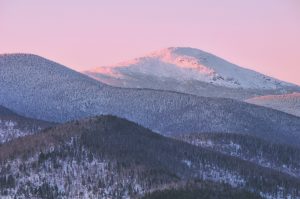
On Saturday, January 6, 2018, 14 of us set out to hike over nine summits. We would be covering about 24 miles on snowshoe in the Adirondacks in what we anticipated would be one long day. Our route would take us to the summits of Haystack, Basin, Saddleback, Gothics, Armstrong, Upper Wolfjaw, and Lower Wolfjaw. The behind-the scenes-work started almost a year in advance. The date was locked down and the course set. The closer we got, the more excited I got. The extended forecast looked perfect. Then, a deep, record-setting freeze descended on the East Coast.
Jan. 4: Thursday morning: I arrived a day early to scout our exit trail and found 3- to 4-footsnowdrifts covering the trail. Hiking through those in the dark, late in the day on Saturday would be dangerous. I consulted a few local friends who know the Great Range and surrounding trails quite well. We discussed the weather. Forecasts called for a high of -6F and low of -24F, with wind chills as low as -60 F. There was no room for error of any kind; any issue or accident could turn life-threatening very quickly, especially above treeline.
Jan. 4: Thursday afternoon. We would stick with the planned course, the Great Range, making two changes to the original plan: we’d skip Haystack due to the amount of time we would be above treeline, and the exit route was changed to avoid the trail with heavy snowdrifts. Emergency bailout points were documented and maps were updated. We were ready, and ready to turn back when we needed to. We talked about what-ifs… What if someone gets hurt miles from our support team? We would be carrying safety gear. Our group consisted of trekkers who were trained in medical and wilderness first-aid, and we would begin to self-rescue in the event of an issue. If someone needed to bail, multiple participants would hike out to our support team.
Jan. 5: Friday evening. We had a great dinner in Keene, NY, catching up with each other, reviewing the safety plan, the route, and the bailout points. Everyone was nervous due to the weather and we had a few people cancel earlier in the week due to the forecast. I was nervous for myself, and for everyone involved. We are risk takers, but we like calculated risks. Winter hiking is our passion and this was going to be a great test.
Jan 6: Saturday morning. I woke up at 2:45 a.m. and we arrived at the trailhead around 4:15 a.m.. The parking lot was empty—rare this time of the year, but given the weather, not a surprise. We put our snowshoes on, said goodbye to our support crew, and hit the trail in the dark. Even in the dark, the trail was gorgeous. It was -15 to -20F but once we started to climb we warmed up quickly. Bringing up the rear, I was able to watch the line of headlights shining in the dark. It was an amazing feeling. A bit into the first climb, we stopped to check in with each other. A few people decided that they would be turning back after the first summit, about 7 miles in. This was a planned bailout point, as we had a support team member hiking with us in anticipation of trekkers turning back.
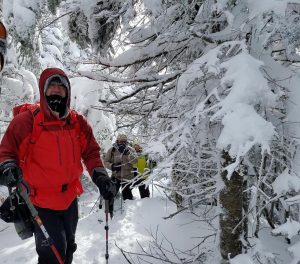
Jan. 6: Saturday, dawn. Dawn came as we were just a bit below treeline. The trail and snow were amazing. People who don’t hike in winter are frequently in awe of the beauty when they see photos of the snow-covered peaks. Six trekkers assesd their comfort level—mental and physical—with the conditions, and chose to not continue on above treeline. They hiked back, along with our support team member. The rest of the team—eight of us, including Lance Parker—headed to our first summit.
Jan. 6: Summit 1: Mount Marcy. Lance stationed himself below the first summit, checking in with each trekker. Winds were gusting between 45 and 60 miles per hour, and it was a challenge to communicate with each other. A portion of the group remained at treeline, rather than face the wind on the summit. The remainder of the group quickly summited and we regrouped at the trail junction. Each of us was prepared to hike out at this point. After a quick assessment to check for hypothermia, nutrition, hydration, and condition, everyone was ready to continue on with the trek.
Jan. 6: Summit of Little Haystack. The trek towards Little Haystack was uneventful. At the summit, we admired the views and reflected on our course change: we had opted to skip the trek over to Haystack. There was no doubt that we made the right decision. We pushed on towards our next summit.
Jan. 6: Summit of Basin. We were deep in the woods on unbroken trail as we headed towards Basin. Lance and another personwere breaking trail. At the base, we decided to climb at a steady pace as a group, push over the summit, and descend right away. I knew this would be fun because it’s a great little climb and really gets people excited, especially those who are seeing it for the first time. We worked our way up; the snow was gorgeous but quite fine, which made the climb a challenge. We worked together and shared lots of smiles and laughs along the way. The views at the top were incredible.
Jan. 6: Summit of Saddleback. We descended Basin and began the climb to Saddleback. The view from Saddleback is one of my favorites and I couldn’t wait for everyone to experience it. Everyone was in a great mood and we were constantly checking in on each other. Three trekkers decided that they were going to hike out via a bailout trail after Saddleback and meet our support crew for pickup.
Once we reached the Saddleback wall, our final ascent was underway, with four technical sections between us and the summit. Lance climbed the first section and was helping each trekker navigate the section; taking packs and tossing them up to solid ground, directing trekkers on the safest footholds, helping them up the wall of rock and ice. I stayed at the end of the line guiding trekkers up towards Lance. To keep the group moving, Andy V. took over Lance’s spot, helping trekkers through this section, and Lance moved on to the second section, moving trekkers forward. This second section was short and we strategically positioned ourselves so each trekker could move across this section.
The next two sections proved a challenge. We went one at a time, and with some trial and error and a lot of team work, we pushed through them. These sections took us much longer than planned to work through.
Once through the technical sections, we summited Saddleback and quickly dipped back into the woods for the descent—a challenge as well due to an unbroken trail. But the group was in good spirits.
Jan. 6: Summit of Gothics. We had a four mile trek to our next summit. After discussing what we had worked through and what lay ahead, we agreed it was not safe to continue. The weather and the conditions weren’t in our favor. Normally, I would say bailing was a hard decision but because we all had each other’s safety as the priority it was a surprisingly easy decision.
Jan. 6: Bailout to the Garden. We began the trek towards the Garden parking lot. This is a long hike and we had hours to go. We had to keep our spirits up, take care of ourselves, and keep moving. As we dug for our headlamps and bundled up for the final push, we again discussed safety. We would hike on and stop at the warming hut around three miles away before the final push to the parking lot. There was little conversation at this point, but I was happy with our effort and thrilled that we had such a great adventure with everyone safe.
We made it to the warming hut and were greeted by a dozen guys from New Jersey. They listened to stories of our adventure and fed us. They were so nice and so welcoming, it was hard to leave. But back into the cold we went; our support team was waiting for us about an hour away in the parking lot, with three warm vehicles and food. Once we reached the parking lot, our support team contacted law enforcement and park rangers to let them know we were out, per our safety plan.
Jan. 6: Keene trek headquarters The first group of trekkers welcomed us, helped pull off frozen gear and gave us warm food and drinks. Everyone was together again, sharing stories about their experiences and enjoying each other’s company. It seemed odd that we were celebrating, but half the fun was the nature of the event and participants. While we failed to finish Extremus for the third year in a row, everyone was satisfied with the adventure.
I was so excited to get my boots off and just hang out and talk about our day. Saturday night was celebratory, reminiscent of Friday night, but without the underlying nervousness. We were unsuccessful in our attempt, but met our two goals (a winter adventure and nobody was injured). Well, almost no injuries…
I went into one of the bedrooms, changed into warm clothes and grabbed a pair of dry wool socks. I walked into the living room in bare feet and grabbed a spot on the couch. Someone immediately noticed my toes and all of a sudden that was the focus. My toes were cold but I didn’t think much of it as they have been this cold before. Little did I know, I had frostbite. I must have lost feeling at some point so I didn’t realize that I was in danger. Luckily, we had a doctor, an ER nurse, and Wilderness First Responders in the cabin. We thawed my feet in lukewarm water for a while, and then went to an emergency room where the diagnosis was confirmed.
Reflection: I venture into the woods daily and for extended trips on weekends. I’ve been winter camping for 20-plus years, and have explored the mountains on skis and snowshoes every winter since I moved to Vermont ten years ago. I’ve never had frostbite.
Because of the immediate treatment and a follow up with my doctor the next day I was able to heal. It’s been challenging, to say the least, but a great learning experience.
Of course, 2019 Extremus planning is already underway. An important part of any challenge is looking at what went well and where there were weaknesses. We’ll reflect on Extremus 2018’s challenges as we plan, train and prepare for our next trek. And then we wait… for the weather.

